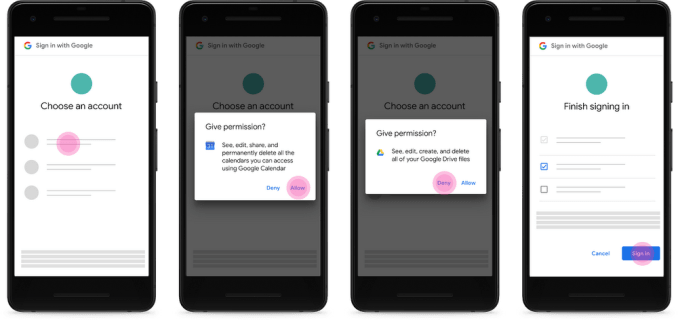Google+ is shutting down at last. Google announced today it’s sunsetting its consumer-facing social network due to lack of user and developer adoption, low usage and engagement. Oh, and a data leak. It even revealed how poorly the network is performing, noting that 90 percent of Google+ user sessions are less than five seconds long. Yikes.
But things weren’t always like this. Google+ was once heralded as a serious attempt to topple Facebook’s stranglehold on social networking, and was even met with excitement in its first days.
2011
June: The unveiling
The company originally revealed its new idea for social networking in June 2011. It wasn’t Google’s first foray into social, however. Google had made numerous attempts to offer a social networking service of some sort, with Orkut, launched in 2004 and shuttered in fall 2014; Google Friend Connect in 2008 (retired in 2012); and Google Buzz in 2010 (it closed the next year).
But Google+ was the most significant attempt the company had made, proclaiming at the time: “we believe online sharing is broken.”
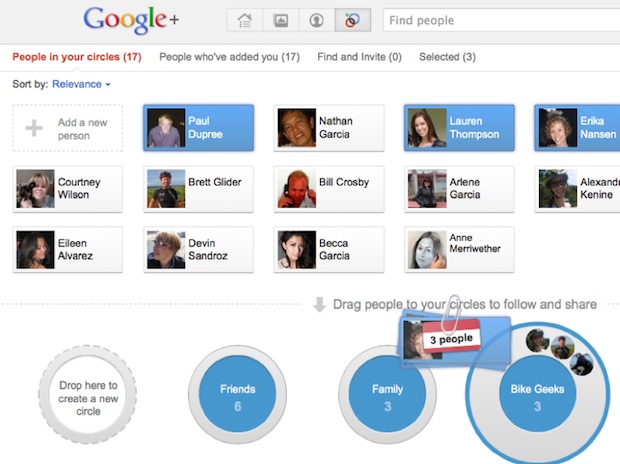
The once top-secret project was the subject of several leaks ahead of its launch, allowing consumer interest in the project to build.
Led by Vic Gundotra and Bradley Horowitz, Google’s big idea to fix social was to get users to create groups of contacts — called “Circles” — in order to have more control over social sharing. That is, there are things that are appropriate for sharing with family or close friends, and other things that make more sense to share with co-workers, classmates or those who share a similar interest — like biking or cooking, for example.
But getting users to create groups is difficult because the process can be tedious. Google, instead, cleverly designed a user interface that made organizing contacts feel simpler — even fun, some argued. It also was better than the system for contact organization that Facebook was offering at the time.
Next thing you know, everyone was setting up their Circles by dragging-and-dropping little profile icons into these groups, and posting updates and photos to their newly created micro-networks.
Another key feature, “Sparks,” helped users find news and content related to a user’s particular interests. This way, Google could understand what people liked and wanted to track, without having an established base of topical pages for users to “Like,” as on Facebook. But it also paved the way for a new type of search. Instead of just returning a list of blue links, a search on Google+ could return people’s profiles who were relevant to the topic at hand, matching pages and other content.
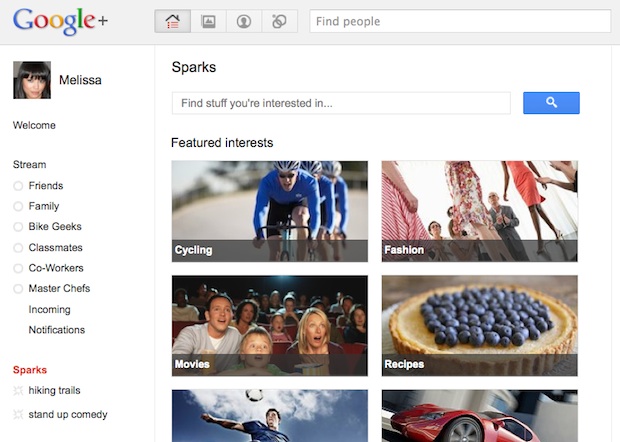
Google+ also introduced Hangouts, a way to video chat with up to 10 people in one of your Circles at once.
At the time, the implementation was described as almost magical. This was due to a number of innovative features, like the way the software focused in on the person talking, for example, and the way everyone could share content within a chat.
Early growth looked promising
Within two weeks, it seemed Google had a hit on its hands, as the network had reached 10 million users. Just over a month after launch, it had grown to 25 million. By October 2011, it reached 40 million. And by year-end, 90 million. Even if Google was only tracking sign-up numbers, it still appeared like a massive threat to Facebook.
Facebook CEO Mark Zuckerberg’s first comment about Google+, however, smartly pointed out that any Facebook competitor will have to build up a social graph to be relevant. Facebook, which had 750 million users at the time, had already done this. Google+ was getting the sign-ups, but whether users would remain active over time was still in question.
There also were early signs that Google+’s embrace of non-friends could be challenging. It had to roll out blocking mechanisms months after launch, as the network became too spammy with unwanted notifications. Over the years that followed, its inability to control the spam became a major issue.
Even as late at 2017, people were still complaining that spam made Google+ unusable.

July: Backlashes over brands and Real Names policy
In an effort to compete with Facebook, Google+ also enforced a “real names” policy. This angered many users who wanted to use pseudonyms or nicknames, especially when Google began deleting their accounts for non-compliance. This was a larger issue than merely losing social networking access, because losing a Google account meant losing Gmail, Documents, Calendar and access to other Google products, too.
The company also flubbed its handling of brands’ pages, banning all Google business profiles in an ill-conceived fashion — something it later admitted was a mistake.
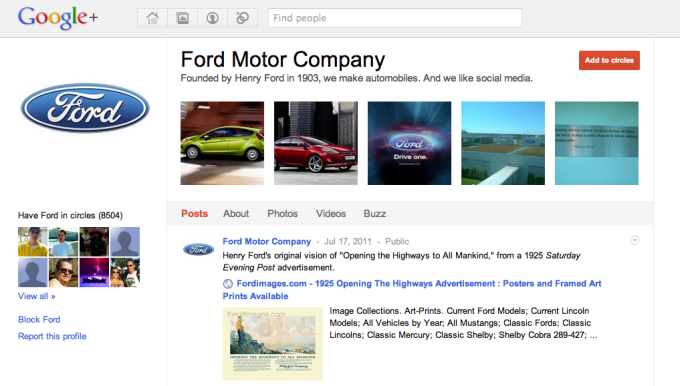
It wouldn’t fix some of these problems for years, in fact. Eric Schmidt even reportedly once suggested finding another social network if you didn’t want to use your real name — a comment that came across as condescending.
August: Social search
Google+ came to Google Search in August. The company announced Google+ posts would begin appearing in “social search” results that showed when users were signed in. Google called this new toggle “search plus your world.” But its slice of “your world” was pretty limited, as it couldn’t see into the posts shared among your friends and followers on Facebook and Twitter.

2012
January: Forced Google+ account creation
If you can’t beat ’em, force ’em! Google began to require users to have a Google+ account in order to sign up for Gmail. It was not a user-friendly change, and was the start of a number of forced integrations to come.
March: Criticism mounts
TechCrunch’s Devin Coldewey argued that Google failed to play the long game in social, and was too ambitious in its attempt with Google+. All the network really should have started with was its “+1” button — the clicks would generate piles of data tied to users that could then be searchable, private by default and shareable elsewhere.
June: Event spam goes viral
Spam remained an issue on Google+. This time, event spam had emerged, thanks to all the nifty integrations between Google+ and mission-critical products like Calendar.
Users were not thrilled that other people were able to “invite” them to events, and these automatically showed up on your Calendar — even if you had not yet confirmed that you would be attending. It made using Google+ feel like a big mistake.
November: Hangouts evolves
The following year after Google+’s launch, there was already a lot of activity around Hangouts — which interestingly, has since become one of the big products that will outlive its original Google+ home.
Video was a tough space to get right — which is why businesses like Skype were still thriving. And while Hangouts were designed for friends and family to use in Google+, Google was already seeing companies adopt the technology for meetings, and brands like the NBA for connecting with fans.

December: Google+ adds Communities
The focus on user interests in Google+ also continued to evolve this year with the launch of Communities — a way for people to set up topic-based forums on the site. The move was made in hopes of attracting more consumer interest, as growth had slowed.
2013
It’s not a destination; it’s a “social layer!”
Google+ wasn’t working out as a “Facebook killer.” Engagement was low, distribution was mixed and it seemed it was only being used by tech early adopters, not the mainstream. So the new plan was to double down on Google+ not being a destination website, like Facebook, but rather make it a social layer across Google products.
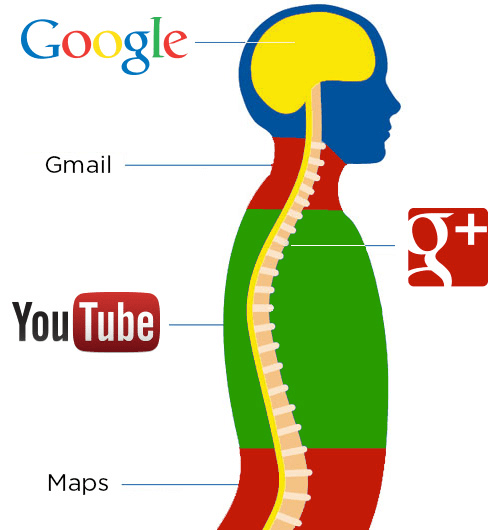 It had already integrated Google+ with Gmail and Google Contacts, shortly after its launch. In June 2013, it offered a way for people to follow brands’ pages in Gmail.
It had already integrated Google+ with Gmail and Google Contacts, shortly after its launch. In June 2013, it offered a way for people to follow brands’ pages in Gmail.
It then decided to unify Google Talk (aka Gchat) with Google+ Messenger into Hangouts.
It launched a Google+ commenting system for Blogger.
It replaced Google sign-ins on third-party sites with Google+ logins.
It was all a bit much.
September: Google+ infiltrates YouTube
Then, most controversially, it took over YouTube comments. Now, if you wanted to comment on YouTube, you needed a Google+ account.
In other words, if Gmail’s then 200+ million users could juice up Google+, then maybe YouTube’s millions of commenters could, Google hoped.
People were not happy, to say the least.
It was a notable indication of how little love people had for Google+. YouTubers were downright pissed. One girl even crafted a profane music video in response, with lyrics like “You ruined our site and called it integration / I’m writing this song just to vent our frustration / Fuck you, Google Plusssssss!”
Google also started talking about Google+ as an “identity layer” with 500 million users to make it sound big.
2014
April: Vic Gundotra, Father of Google+, leaves Google
Google+ lost its founder. In April 2014, it was announced that Vic Gundotra, the father of Google+, was leaving the company. Google CEO Larry Page said at the time that the social network would still see investment, but it was a signal that a shift was coming in terms of Google’s approach.

Former TechCrunch co-editor Alexia Bonatsos (née Tsotsis) and editor Matthew Panzarino wrote at the time that Google+ was “walking dead,” having heard that Google+ was no longer going to be considered a product, but a platform.
The forced integrations of the past would be walked back, like those in Gmail and YouTube, and teams would be reshuffled.
July: Hangouts breaks free
Perhaps one of the most notable changes was letting Hangouts go free. Hangouts was a compelling product — too important to require a tie to Google+. In July 2014, Hangouts began to work without a Google+ account, rolled out to businesses and got itself an SLA.

July: Google+ drops its “real name” rule and apologizes
Another signal that Google+ was shifting following Gundotra’s exit was when it abandoned its “real name” policy, three years after the user outrage.
While Google had started rolling back on the real name policy in January of 2012 by opening rules to include maiden names and select nicknames, it still displayed your real name alongside your chosen name. It was nowhere near what people wanted.
Now, Google straight-up apologized for its decision around real names and hoped the change would bring users back. It did not. It was too late.
2015
May: Google Photos breaks free
Following Hangouts, Google realized that Google+’s photo-sharing features also deserved to become their own, standalone product.
At Google I/O 2015, the company announced its Google Photos revamp. The new product took advantage of AI and machine learning capabilities that originated on Google+. This included allowing users to search photos for persons, places and things, as well as an update on Google+’s “auto awesome” feature, which turned into the more robust Google Photos Assistant.
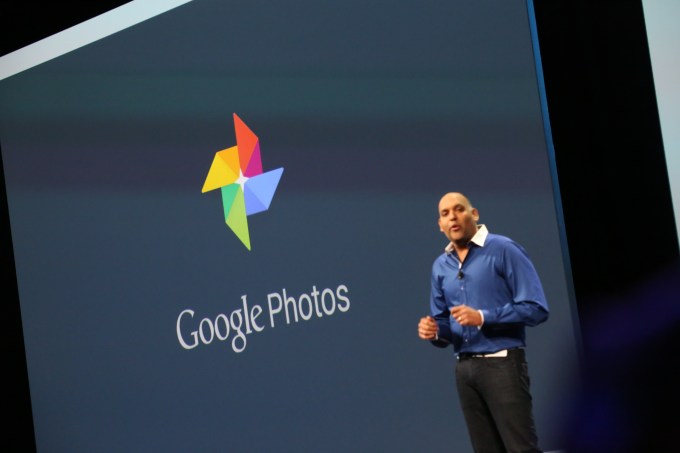
Later that year, Google Photos had scaled to 100 million monthly active users, after shutting down Google+ Photos in August 2015.
July: Google+ pulled from YouTube
In July 2015, Google reversed course on YouTube integrations with Google+ so YouTube comments stayed on YouTube, and not on Google+.
People were happy about this. But not happy enough to go back to Google+.
November: An all-new Google+ unveiled
Google+ got a big revamp in November 2015.
Bradley Horowitz, VP, Photos and Streams at Google and Product Director at Google, Luke Wroblewski, had teamed up to redesign Google+ around what Google’s data indicated was working: Communities and Collections. Essentially, the new Google+ was focused on users and their interests. It let people network around topics, but not necessarily their personal connections.
Google also rolled out “About Me” pages as an alternative to sites like About.me.
The new site got a colorful coat of paint, too, but it never regained traction.
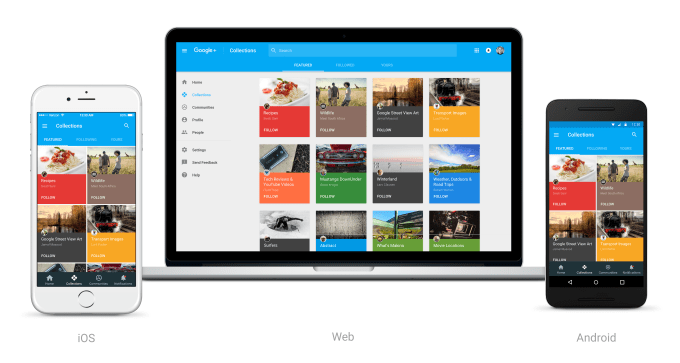
2016
January: Google+ pulled from Android Gaming service
Google decoupled Google+ from another core product by dropping the requirement to have an account with the social network in order to use the Google Play Games services.
August: Google+ pulled from Play Store
The unbundling continued, as Google’s Play Store stopped requiring users to have a Google+ account to write reviews.
Horowitz explained at the time that Google had heard from users “that it doesn’t make sense for your Google+ profile to be your identity in all the other Google products you use,” and it was responding accordingly.
August: Hangouts on Air moved to YouTube Live
One of the social network’s last exclusive features, Hangouts on Air — a way to broadcast a Hangout — moved to YouTube Live in 2016, as well.
2017
Google+ went fairly quiet. The site was still there, but the communities were filling with spam. Community moderators said they couldn’t keep up. Google’s inattention to the problem was a signal in and of itself that the grand Google+ experiment may be coming to a close.
January: Classic design phased out
Google+ forced the change over to the new design first previewed in late 2015.
In January 2017, it no longer allowed users to switch back to the old look. It also took the time to highlight groups that were popular on Google+ to counteract the narrative that the site was “dead.” (Even though it was.)
August: Google+ removed share count from +1 button
The once ubiquitous “+1” button, launched in spring 2012, was getting a revamp. It would no longer display the number of shares. Google said this was to make the button load more quickly. But it was really because the share counts were not worth touting anymore.
2018
October 2018: Google+ got its Cambridge Analytica moment
A security bug allowed third-party developers to access Google+ user profile data since 2015 until Google discovered it in March, but decided not to inform users. In total, 496,951 users’ full names, email addresses, birth dates, gender, profile photos, places lived, occupation and relationship status were potentially exposed. Google says it doesn’t have evidence the data was misused, but it decided to shut down the consumer-facing Google+ site anyway, given its lack of use.
Data misuse scandals like Cambridge Analytica have damaged Facebook and Twitter’s reputations, but Google+ wasn’t similarly impacted. After all, Google was no longer claiming Google+ be a social network. And, as its own data shows, the network that remained was largely abandoned.
But the company still had piles of user profile data on hand, which were put at risk. That may lead Google to face a similar fate as the more active social networks, in terms of being questioned by Congress or brought up in lawmakers’ discussions about regulations.
In hindsight, then, maybe it would have been better if Google had shut down Google+ years ago.

 (@FrankoCurrency)
(@FrankoCurrency) 

